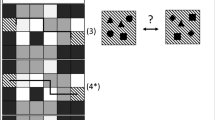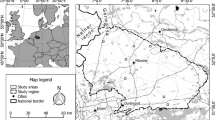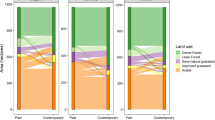Abstract
Identification of trait syndromes that make species vulnerable to habitat fragmentation is essential in predicting biodiversity change. Plants are considered particularly vulnerable if their capacities for persistence in and for dispersal among local habitats are low. Here we investigated the influence of easily measured functional traits on the presence of 45 plant species in an urban landscape in north-west Germany where patches were separated by distances consistent with regular plant dispersal range. To describe the spatial configuration of patches we calculated species-specific patch connectivities. Then we assessed plant connectivity responses in distribution models calculated from connectivities and environmental predictors. Twenty (45%) of the analysed species showed a positive connectivity response after accounting for species-specific habitat requirements. These species differed from non-responsive species by functional traits associated with dispersal, including reduced seed numbers and higher terminal velocities relative to non-responsive species. Persistence traits played however no role which we attribute to the environmental conditions of urban habitats and their spatiotemporal characteristics. Our study underlines that even ruderal plants experience dispersal limitation and demonstrates that easily measured functional traits may be used as indicators of fragmentation vulnerability in urban systems allowing generalizations to larger species sets.



Similar content being viewed by others
References
Askew AP, Corker D, Hodkinson DJ, Thompson K (1997) A new apparatus to measure the rate of fall of seeds. Funct Ecol 11:121–125
Bastin L, Thomas CD (1999) The distribution of plant species in urban vegetation fragments. Landscape Ecol 14:493–507
Bekker RM, Bakker JP, Grandin U, Kalamees R, Milberg P, Poschlod P, Thompson K, Willems JH (1998) Seed size, shape and vertical distribution in the soil: indicators of seed longevity. Funct Ecol 12:834–842
Bossuyt B, Honnay O (2006) Interactions between plant life span, seed dispersal capacity and fecundity determine metapopulation viability in a dynamic landscape. Landscape Ecol 21:1195–1205
Burnham KP, Anderson DR (2002) Model selection and multimodel inference: a practical information-theoretic approach. Springer, New York
Butaye J, Jacquemyn H, Hermy M (2001) Differential colonization causing non-random forest plant community structure in a fragmented agricultural landscape. Ecography 24:369–380
Cain ML, Milligan BG, Strand AE (2000) Long-distance seed dispersal in plant populations. Am J Bot 87:1217–1227
Campbell BD, Grime JP (1992) An experimental test of plant strategy theory. Ecology 73:15–29
Crowley PH, McLetchie DN (2002) Trade-offs and spatial life-history strategies in classical metapopulations. Am Nat 159:190–208
Deutscher Wetterdienst 2006/2007. Mittelwerte des Niederschlags und der Temperatur für den Zeitraum 1961–1990
Díaz S, Hodgson JG, Thompson K, Cabido M, Cornelissen JHC, Jalili A, Montserrat-Martí G, Grime JP, Zarrinkamar F, Asri Y, Band SR, Basconcelo S, Castro-Díez P, Funes G, Hamzehee B, Khoshnevi M, Pérez-Harguindeguy N, Pérez-Rontomé MC, Shirvany FA, Vendramini F, Yazdani S, Abbas-Azimi R, Bogaard A, Boustani S, Charles M, Dehghan M, de Torres-Espuny L, Falczuk V, Guerrero-Campo J, Hynd A, Jones G, Kowsary E, Kazemi-Saeed F, Maestro-Martínez M, Romo-Díez A, Shaw S, Siavash B, Villar-Salvador P, Zak MR (2004) The plant traits that drive ecosystems: evidence from three continents. J Veg Sci 15:295–304
Dirnböck T, Dullinger S (2004) Habitat distribution models, spatial autocorrelation, functional traits and dispersal capacity of alpine plant species. J Veg Sci 15:77–84
Dormann C, McPherson J, Araújo M, Bivand R, Boilliger J, Carl G, Davies RG, Hirzel A, Jetz W, Kissling W, Kühn I, Ohlemüller R, Peres-Neto P, Reineking B, Schröder B, Schurr F, Wilson R (2007) Methods to account for spatial autocorrelation in the analysis of species distributional data: a review. Ecography 30:609–628
Dray S, Legendre P, Peres-Neto PR (2006) Spatial modelling: a comprehensive framework for principal coordinate analysis of neighbour matrices (PCNM). Ecol Model 196:483–493
Dupré C, Ehrlén J (2002) Habitat configuration, species traits and plant distributions. J Ecol 90:796–805
Ehrlén J, Münzbergová Z, Diekmann M, Eriksson O (2006) Long-term assessment of seed limitation in plants: results from an 11-year experiment. J Ecol 94:1224–1232
Ellenberg H (1986) Vegetation Mitteleuropas mit den Alpen in ökologischer Sicht. Ulmer, Stuttgart
ESRI Inc. (2006) ArcMapTM version 9.2. Redlands, California
Ewers R, Didham R (2006) Confounding factors in the detection of species responses to habitat fragmentation. Biol Rev 81:117–142
Fahrig L (2003) Effects of habitat fragmentation on biodiversity. Annu Rev Ecol Evol Syst 34:487–515
Fenner M, Thompson K (2004) The ecology of seeds. Cambridge University Press, Cambridge
Foster BL (2001) Constraints on colonization and species richness along a grassland productivity gradient: the role of propagule availability. Ecol Lett 4:530–535
Freckleton RP, Watkinson AR (2001) Nonmanipulative determination of plant community dynamics. Trends Ecol Evol 16:301–307
Freckleton RP, Watkinson AR (2002) Large-scale spatial dynamics of plants: metapopulations, regional ensembles and patchy populations. J Ecol 90:419–434
Gilbert B, Lechowicz MJ (2004) Neutrality, niches, and dispersal in a temperate forest understory. PNAS 101:7651–7656
Girdler EB, Barrie BTC (2008) The scale-dependent importance of habitat factors and dispersal limitation in structuring Great Lakes shoreline plant communities. Plant Ecol 198:211–223
Goldberg DE, Barton AM (1992) Patterns and consequences of interspecific competition in natural communities—a review of field experiments with plants. Am Nat 139:771–801
Grashof-Bokdam CJ, Geertsema W (1998) The effect of isolation and history on colonization patterns of plant species in secondary woodland. J Biogeogr 25:837–846
Griffith DA, Peres-Neto PR (2006) Spatial modeling in ecology: the flexibility of eigenfunction spatial analyses. Ecology 87:2603–2613
Grime JP, Hodgson JG, Hunt R (1989) Comparative plant ecology: a functional approach to common British species. Unwin Hyman, London
Hanski I (1994) A practical model of metapopulation dynamics. J Anim Ecol 63:151–162
Helm A, Hanski I, Pärtel M (2006) Slow response of plant species richness to habitat loss and fragmentation. Ecol Lett 9:72–77
Henle K, Davies KF, Kleyer M, Margules C, Settele J (2004) Predictors of species sensitivity to fragmentation. Biodivers Conserv 13:207–251
Hérault B, Honnay O (2005) The relative importance of local, regional and historical factors determining the distribution of plants in fragmented riverine forests: an emergent group approach. J Biogeogr 32:2069–2081
Higgins SI, Nathan R, Cain ML (2003) Are long-distance dispersal events in plants usually caused by nonstandard means of dispersal? Ecology 84:1945–1956
Jäger EJ, Werner K (2002) Rothmaler Exkursionsflora von Deutschland. Gefäßpflanzen: Kritischer Band. Spektrum Akademischer Verlag, Heidelberg Berlin
Johst K, Brandl R, Eber S (2002) Metapopulation persistence in dynamic landscapes: the role of dispersal distance. Oikos 98:263–270
Kattwinkel M, Strauss B, Biedermann R, Kleyer M (2009) Modelling multi-species response to landscape dynamics: mosaic cycles support urban biodiversity. Landscape Ecol 24:929–941
Kleyer M, Bekker RM, Knevel IC, Bakker JP, Thompson K, Sonnenschein M, Poschlod P, van Groenendael JM, Klimeš L, Klimešová J, Klotz S, Rusch GM, Hermy M, Adriaens D, Boedeltje G, Bossuyt B, Endels P, Götzenberger L, Hodgson JG, Jackel A-K, Dannemann A, Kühn I, Kunzmann D, Ozinga WA, Römermann C, Stadler M, Schlegelmilch J, Steendam HJ, Tackenberg O, Wilmann B, Cornelissen JHC, Eriksson O, Garnier E, Fitter A, Peco B (2008) The LEDA Traitbase: a database of life-history traits of the Northwest European flora. J Ecol 96:1266–1274
Kolb A, Diekmann M (2005) Effects on life-history traits on responses of plant species to forest fragmentation. Conserv Biol 19:929–938
Krauss J, Klein AM, Steffan-Dewenter I, Tscharntke T (2004) Effects of habitat area, isolation, and landscape diversity on plant species richness of calcareous grasslands. Biodivers Conserv 13:1427–1439
Legendre P, Legendre L (2006) Numerical ecology. Elsevier, Amsterdam
Moilanen A, Nieminen M (2002) Simple connectivity measures in spatial ecology. Ecology 83:1131–1145
Nathan R (2006) Long-distance dispersal of plants. Science 313:786–788
Nathan R, Katul GG, Horn HS, Thomas SM, Oren R, Avissar R, Pacala SW, Levin SA (2002) Mechanisms of long-distance dispersal of seeds by wind. Nature 418:409–413
Nathan R, Schurr FM, Spiegel O, Steinitz O, Trakhtenbrot A, Tsoar A (2008) Mechanisms of long-distance seed dispersal. Trends Ecol Evol 23:638–647
Ozinga WA, Bekker RM, Schminée JHJ, van Groenendael JM (2004) Dispersal potential in plant communities depends on environmental conditions. J Ecol 92:767–777
Ozinga WA, Römermann C, Bekker RM, Prinzing A, Tamis WLM, Schaminée JHJ, Hennekens SM, Thompson K, Poschlod P, Kleyer M, Bakker JP, van Groenendael JM (2009) Dispersal failure contributes to plant losses in NW Europe. Ecol Lett 12:66–74
Piessens K, Honnay O, Hermy M (2005) The role of fragment area and isolation in the conservation of heathland species. Biol Conserv 122:61–69
Prugh LR, Hodges KE, Sinclair ARE, Brashares JS (2008) Effect of habitat area and isolation on fragmented animal populations. PNAS 105:20770–20775
Schadek U (2006) Plants in urban brownfields: modelling the driving factors of site conditions and of plant functional group occurrence in a dynamic environment. Dissertation, University of Oldenburg
Schadek U, Strauss B, Biedermann R, Kleyer M (2009) Plant species richness, vegetation structure and soil resources of urban brownfield sites linked to successional age. Urban Ecosyst Online First 115–126
Schaffers AP, Sykora KV (2000) Reliability of Ellenberg indicator values for moisture, nitrogen and soil reaction: a comparison with field measurements. J Veg Sci 11:225–244
Schippers P, van Groenendael JM, Vleeshouwers LM, Hunt R (2001) Herbaceous plant strategies in disturbed habitats. Oikos 95:198–210
Soons MB, Nathan R, Katul GG (2004) Human effects on long-distance wind dispersal and colonization by grassland plants. Ecology 85:3069–3079
Soons MB, Messlink JH, Jongejans E, Heil GW (2005) Habitat fragmentation reduces grassland connectivity for both short-distance and long-distance wind-dispersed forbs. J Ecol 93:1214–1225
SPSS Inc. (2006) SPSS version 15.0.1 for Windows. Chicago, USA
Steyerberg EW, Harrell FE, Borsboom GJJM, Eijkemans MJC, Vergouwe Y, Habbema JDF (2001) Internal validation of predictive models: efficiency of some procedures for logistic regression analysis. J Clin Epidemiol 54:774–781
Strauss B, Biedermann R (2006) Urban brownfields as temporary habitats: driving forces for the diversity of phytophagous insects. Ecography 29:928–940
Suding KN, Goldberg DE, Hartman KM (2003) Relationships among species traits: separating levels of response and identifying linkages to abundance. Ecology 84:1–16
Tackenberg O, Poschlod P, Bonn S (2003) Assessment of wind dispersal potential in plant species. Ecol Monogr 73:191–205
Tilman D, May RM, Lehman CL, Nowak MA (1994) Habitat destruction and the extinction debt. Nature 371:65–66
Tremlová K, Münzbergová Z (2007) Importance of species traits for species distribution in fragmented landscapes. Ecology 88:965–977
Verheyen K, Vellend M, van Calster H, Peterken G, Hermy M (2004) Metapopulation dynamics in changing landscapes: a new spatially realistic model for forest plants. Ecology 85:3302–3312
Vos CC, Verboom J, Opdam PFM, ter Braak CJF (2001) Toward ecologically scaled landscape indices. Am Nat 157:24–41
Westoby M, Falster DS, Moles AT, Vesk PA, Wright IJ (2002) Plant ecological strategies: some leading dimensions of variation between species. Annu Rev Ecol Syst 33:125–159
Acknowledgments
This study was conducted as part of the collaborative research project ASSEMBLE within the ESF-Eurodiversity Programme (05_EDIV_FP040-ASSEMBLE) and was supported by the German Science Foundation (KL 756/2-1) and the European Science Foundation. We thank H.J. Poethke and N. Mason for useful comments on the manuscript, K. Thompson who did the seed terminal velocity measurements as part of the LEDA project and U. Schadek for providing plant trait data and the many students having assisted in collecting field data.
Author information
Authors and Affiliations
Corresponding author
Electronic supplementary material
Below is the link to the electronic supplementary material.
Rights and permissions
About this article
Cite this article
Schleicher, A., Biedermann, R. & Kleyer, M. Dispersal traits determine plant response to habitat connectivity in an urban landscape. Landscape Ecol 26, 529–540 (2011). https://doi.org/10.1007/s10980-011-9579-1
Received:
Accepted:
Published:
Issue Date:
DOI: https://doi.org/10.1007/s10980-011-9579-1




